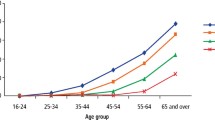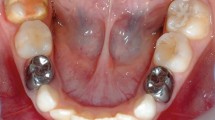Abstract
Periodontal disease is considered to increase in prevalence around adolescence, owing to pubertal hormonal changes, early presentation in at-risk individuals and the challenges in maintaining patient motivation at this age. Adolescence provides the ideal stage of dental development for orthodontic assessment. Active periodontal disease can increase tooth mobility during orthodontic treatment. Therefore, it is essential that children and adolescents have appropriate and timely periodontal screening before commencing orthodontic treatment. The British Society of Periodontology and the British Society of Paediatric Dentistry recommend a modified Basic Periodontal Examination (BPE) assessing index teeth for paediatric patients.
This paper will summarise the recommended paediatric periodontal assessment and review a case which highlights the need for routine periodontal examination of orthodontic patients, by both general dental practitioners and orthodontists, to identify patients at risk for periodontal disease. The modified BPE for this younger cohort is simple and allows for rapid screening of periodontal disease. Where it is needed, further detailed examination and treatment can then be initiated to prevent exacerbation of an existing problem.
Key points
-
It is essential for general dental practitioners, orthodontists and patients to work together to enable early identification of periodontal disease.
-
Periodontal examinations should be performed before specialist referral, and followed up with continued monitoring during and after treatment.
-
In paediatric patients, periodontal examination should include the simplified BPE as a minimum requirement.
This is a preview of subscription content, access via your institution
Access options
Subscribe to this journal
Receive 24 print issues and online access
$259.00 per year
only $10.79 per issue
Buy this article
- Purchase on Springer Link
- Instant access to full article PDF
Prices may be subject to local taxes which are calculated during checkout



Similar content being viewed by others
References
British Society of Periodontology. The Good Practitioner's Guide to Periodontology. Liverpool: BSP, 2016.
Marsh P D. Dental plaque as a biofilm and a microbial community - implications for health and disease. BMC Oral Health 2006; 6 Suppl 1(Suppl 1): S14.
British Society of Periodontology and Implant Dentistry. Executive Summary - Guidelines for Periodontal Screening and Management of Children and Adolescents Under 18 years of Age. 2012. Available at https://www.bsperio.org.uk/assets/downloads/executive-summary-bsp_bspd-perio-guidelines-for-the-under-18s.pdf (accessed March 2021).
Bimstein E, Eidelman E. Growth and development considerations in the diagnosis of gingivitis and periodontitis in children. Pediatr Dent 1999; 21: 186-191.
White D A, Chadwick B L, Nuttall N M, Chestnutt I G, Steele J G. Oral health habits among children in the United Kingdom in 2003. Br Dent J 2006; 200: 487-491.
Clerehugh V, Lennon M A, Worthington H V. Five-year results of a longitudinal study of early periodontitis in 14 to 19-year-old adolescents. J Clin Periodontol 1990; 17: 702-708.
Jenkins W M M, Papapanou P N. Epidemiology of periodontal disease in children and adolescents. Periodontol 2000 2001; 26: 16-32.
Greer A C, Murray A M, Vere J W. Periodontal exams for adult orthodontic patients. Orthod Update 2018; 11: 145-149.
British Orthodontic Society. The Role of the Orthodontist in Maintaining Oral Health (BOS Advice Sheet).2017.
Travess H, Roberts-Harry D, Sandy J. Orthodontics. Part 6: Risks in orthodontic treatment. Br Dent J 2004; 196: 71-77.
Hazan-Molina H, Levin L, Einy S, Aizenbud D. Aggressive Periodontitis Diagnosed During or Before Orthodontic Treatment. Acta Odontol Scand 2013; 71: 1023-1031.
Gyawali R, Bhattarai B. Orthodontic management in aggressive periodontitis. Int Sch Res Notices 2017; DOI: 10.1155/2017/8098154.
Johnston C, Burden D, Morris D. Clinical Guidelines: Orthodontic retention. 2008. Available at https://www.bos.org.uk/portals/0/Public/docs/clinical-guidelines-retention-final-version-august-2013.pdf (accessed June 2021).
Sharpe W, Reed B, Subtelny J D et al. Orthodontic relapse, apical root resorption, and crestal alveolar bone levels. Am J Orthod Dentofacial Orthop 1987; 91: 252-258.
Littlewood S J, Millett D T, Doubleday B et al. Retention procedures for stabilising tooth position after treatment with orthodontic braces. Cochrane Database Syst Rev 2016; DOI: 10.1002/14651858.CD002283.pub4.
Caton J G, Armitage G, Berglundgh T et al. A new classification scheme for periodontal and peri-implant diseases and conditions - Introduction and key changes from the 1999 classification. J Clin Periodontol 2018; 45 Suppl 20: S1-S8.
Armitage G C. Development of a classification system for periodontal diseases and conditions. Ann Periodontol 1999; 4: 1-6.
Dietrich T, Ower P, Tank M et al. Periodontal diagnosis in the context of the 2017 classification system of periodontal diseases and conditions - implementation in clinical practice. Br Dent J 2019; 226: 16-22.
Ainamo J, Nordblad A, Kallio P. Use of the CPITN in populations under 20 years of age. Int Dent J 1984; 34: 285-291.
British Society of Periodontology. Implementing the 2017 Classification of Periodontal Diseases to Reach a Diagnosis in Clinical Practice. 2018.Available at https://www.bsperio.org.uk/assets/downloads/111_153050_bsp-flowchart-implementing-the-2017-classification.pdf (accessed June 2021).
Khattri S, Arora A, Sumanth K N et al. Adjunctive Systemic Antimicrobials for the Non-Surgical Treatment of Chronic and Aggressive Periodontitis. Cochrane Database Syst Rev 2017; DOI: 10.1002/14651858.CD012568.pub2.
Akincibay H, Orsal S, Sengün D, Tözüm T. Systemic administration of doxycycline versus metronidazole plus amoxicillin in the treatment of localized aggressive periodontitis: a clinical and microbiologic study. Quintessence Int 2008; 39: e33-e39.
Rooney J, Wade W G, Sprague S V, Newcombe R G, Addy M. Adjunctive effects to non-surgical periodontal therapy of systemic metronidazole and amoxicillin alone and combined. A placebo controlled study. J Clin Periodontol 2002; 29: 342-350.
Ao H, Deng X, She Y et al. A biopsychosocial-cultural model for understanding oral-health-related quality of life among adolescent orthodontic patients. Health Qual Life Outcomes 2020; 18: 86.
Deng X, Wang Y, Deng F, Liu P, Wu Y. Psychological well-being, dental esthetics, and psychosocial impacts in adolescent orthodontic patients: A prospective longitudinal study. Am J Orthod Dentofacial Orthop 2018; DOI: 10.1016/j.ajodo.2017.05.028.
Public Health England. Delivering Better Oral Health: An Evidence Based Toolkit for Prevention. London: Department of Health, 2017.
Author information
Authors and Affiliations
Corresponding author
Ethics declarations
The authors declare that there are no conflicts of interest.
Rights and permissions
About this article
Cite this article
Dale, C., Smorthit, K., Storey, M. et al. The importance of the Basic Periodontal Examination for paediatric orthodontic patients. Br Dent J 231, 163–168 (2021). https://doi.org/10.1038/s41415-021-3292-5
Received:
Accepted:
Published:
Issue Date:
DOI: https://doi.org/10.1038/s41415-021-3292-5
This article is cited by
-
Necrotising gingivitis and the dental team
BDJ Team (2024)



